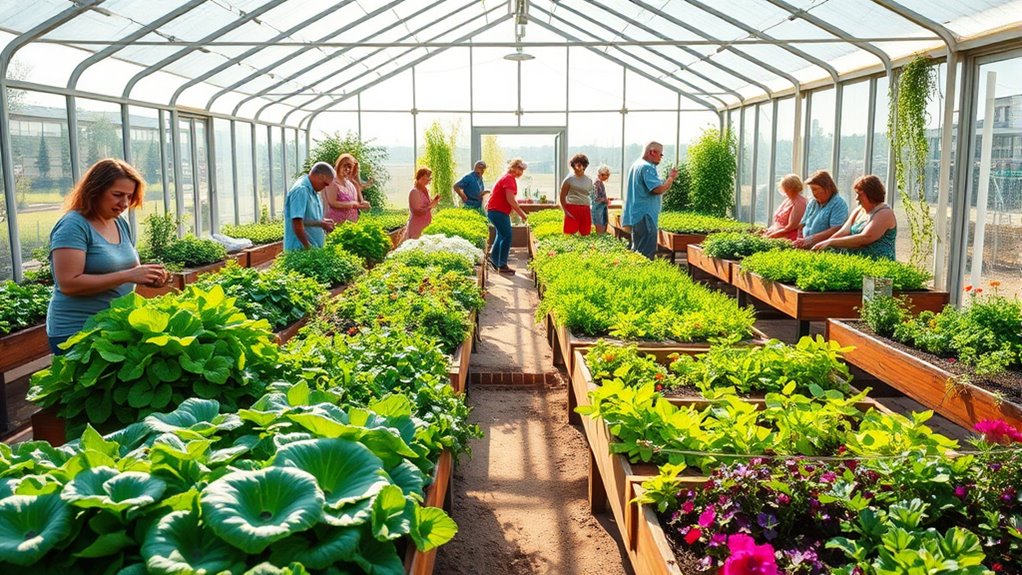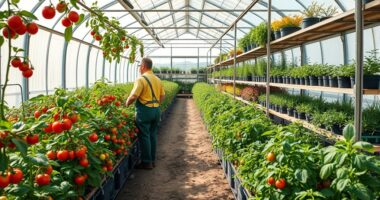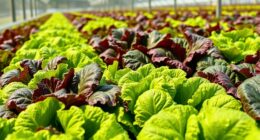Community greenhouses bring neighbors together by transforming vacant lots into shared spaces for sustainable gardening and urban farming. You’ll collaborate on growing fresh food, learn eco-friendly techniques, and build stronger bonds with others in your neighborhood. These green spaces foster pride, promote environmental responsibility, and improve local food security. If you want to see how these projects turn communities into vibrant, resilient hubs, there’s more to discover below.
Key Takeaways
- Community greenhouses foster collaboration among neighbors through shared gardening spaces and collective sustainability projects.
- They promote social bonds by encouraging diverse residents to work together on urban farming initiatives.
- Greenhouses serve as educational hubs, offering workshops that unite community members around eco-friendly practices.
- They transform vacant land into vibrant, productive areas, strengthening neighborhood pride and ownership.
- These spaces enhance local food security and environmental awareness through collective effort and sustainable gardening.

Have you ever wondered how communities can come together to grow fresh, healthy food? Community greenhouses are a perfect answer. They serve as shared spaces where neighbors collaborate to practice sustainable gardening and urban farming, transforming unused land or vacant lots into productive, green hubs. These structures create opportunities for residents to learn about eco-friendly practices while producing nutritious food without relying heavily on commercial agriculture. By focusing on sustainable gardening, community greenhouses promote environmentally responsible methods, like composting, water conservation, and organic farming techniques, which benefit both the environment and the people involved.
Imagine walking into a community greenhouse, where the air is filled with the scent of freshly sprouted herbs and vegetables. Here, residents of all ages come together, sharing skills and knowledge about urban farming. These greenhouses break down barriers, encouraging diverse groups to work side by side, fostering a sense of belonging and collective purpose. You can participate in planting, watering, and harvesting, gaining practical experience in sustainable gardening that you can replicate at home. This hands-on approach helps neighbors understand the importance of reducing their carbon footprint and making eco-conscious choices. Additionally, integrating Cultural Intelligence into community projects can enhance teamwork and mutual understanding among diverse participants.
Community greenhouses foster shared learning and hands-on gardening, building bonds and promoting eco-friendly habits for all ages.
Community greenhouses also serve as educational centers, especially in urban areas where space for traditional gardening might be limited. They show that urban farming isn’t just a hobby; it’s a practical way to address food insecurity and promote healthier living. As you get involved, you learn how to grow organic produce without harmful chemicals, which makes a real difference in the quality of the food you consume. Plus, these greenhouses often host workshops and training sessions, empowering community members with the skills needed to maintain productive, sustainable gardens year-round.
Another key benefit is the social connection that develops through shared effort. Working together in a community greenhouse creates a stronger neighborhood fabric, encouraging collaboration and mutual support. It’s inspiring to see people from different backgrounds unite over a common goal—producing fresh vegetables, herbs, and flowers. This collective effort not only enhances local food security but also cultivates a sense of pride and ownership among residents. As you contribute to this green space, you become part of a movement that values environmental stewardship and community resilience.
In essence, community greenhouses exemplify how urban farming and sustainable gardening can transform neighborhoods. They turn underused spaces into vibrant, productive areas where neighbors come together to grow food, learn, and build stronger communities. It’s a simple yet powerful way to make a lasting impact—one seed, one plant, and one shared moment at a time.
Frequently Asked Questions
How Can I Start a Community Greenhouse in My Neighborhood?
You can start a community greenhouse in your neighborhood by first organizing a meeting to gather interested neighbors. Focus on community engagement to build support and share ideas. Secure a suitable location and promote sustainable practices like composting and rainwater harvesting. Obtain necessary permits, develop a clear plan, and recruit volunteers. By fostering collaboration, you’ll create a space that benefits everyone while promoting environmental responsibility.
What Is the Average Cost to Build a Community Greenhouse?
Like the seeds of a shared dream, the cost to build a community greenhouse varies widely, typically ranging from $5,000 to $25,000. You should consider cost considerations such as materials, size, and design options, which influence the overall expense. Opting for durable, eco-friendly designs might cost more upfront but save money long-term, creating a space that nurtures your community and fosters growth, much like a well-tended garden.
Are There Grants Available for Community Greenhouse Projects?
Yes, funding opportunities for community greenhouse projects do exist. You can find grants from local government, non-profits, and agricultural agencies. To boost your chances, research grant application tips like demonstrating community impact, providing clear budgets, and aligning your project with funder priorities. Carefully review eligibility criteria, prepare compelling proposals, and submit early. These steps will help you secure the necessary funding to bring your community greenhouse to life.
How Do Community Greenhouses Impact Local Food Security?
Community greenhouses boost local food security by promoting urban farming, increasing access to fresh produce, and fostering food sovereignty. You see more healthy foods growing in your neighborhood, reducing reliance on distant markets. They empower residents to grow their own food, build skills, and strengthen community bonds. This sustainable approach guarantees everyone has reliable access to nutritious options, making your neighborhood more resilient and self-sufficient.
What Are Common Challenges Faced by Community Greenhouse Initiatives?
You might face funding hurdles that make it tough to start or maintain a community greenhouse. Engaging neighbors can also be challenging if people aren’t interested or don’t see the benefits. To overcome these issues, you should seek diverse funding sources and actively promote community involvement. Building strong relationships and showing how the greenhouse benefits everyone can boost engagement and help sustain your project long-term.
Conclusion
Community greenhouses not only grow plants but also grow stronger neighborhoods. When you get involved, you help foster connections and shared purpose. Did you know that over 60% of community greenhouse members report feeling more connected to their neighbors? That sense of togetherness can turn a simple garden into a thriving, supportive space. So, next time you see one, consider joining in—you’re helping build a healthier, happier community, one plant at a time.









